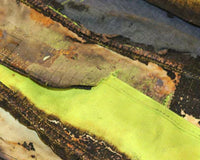There are currently two different types of Arc rated flame resistant (FR) fabrics available on the market - inherently FR fabrics, and treated non-inherently FR fabrics. This is what the majority of protective arc flash clothes are made of.
Inherently FR fabrics
Fabrics like this have been specifically engineered to be flame resistant. As a result, there’s no need for a chemical or chemicals to be added to them for their protective capabilities. The FR properties of these fabrics cannot be diminished over time or through washing them. Most inherently FR fabrics are either aramid or modacrylic.
Pros:
- FR properties can never be washed out (permanent protection)
- Provide a high level of protection
- high thermal protective performance (TPP) score
- will not ignite in normal 02 concentration
Cons:
- Can be expensive
(Inherent Clothing v Treated Clothing)
Treated non-inherently FR fabrics
These types of fabrics are either 100% cotton, or cotton blends with no FR properties and so they require a chemical treatment application in order for them to become flame resistant. If it hasn’t been chemically treated, then even 100% cotton can ignite in the event of an electrical explosion.
Pros:
- Doesn’t contain any synthetic fibres
Cons:
- FR finish is limited to a number of washes (no guarantee that after a few washes the protection is still there)
Our Recommendation
Here at Skanwear, we recommend that when operating in an environment where there is risk of an arc flash happening, workers wear protective clothing made from inherently FR fabrics. Not only will this mitigate risks to the wearer / employer, but it will save money given that the protective qualities last a lifetime - unless they get torn, snagged, or ripped and then they would need replacing.
Regardless of the type of FR fabric being worn, the materials used in arc flash clothing must still be arc rated with either an Arc Thermal Performance Value (ATPV) or an Energy Break-open Threshold (EBT) in order be safe to wear.



